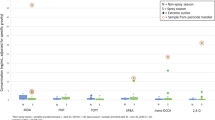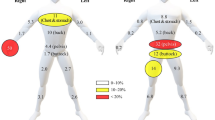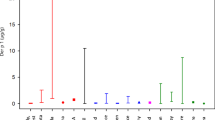Abstract
A subset of private pesticide applicators in the Agricultural Health Study (AHS) epidemiological cohort was monitored around the time of their agricultural use of 2,4-dichlorophenoxyacetic acid (2,4-D) and O,O-diethyl-O-3,5,6-trichloro-2-pyridyl phosphorothioate (chlorpyrifos) to assess exposure levels and potential determinants of exposure. Measurements included pre- and post-application urine samples, and patch, hand wipe, and personal air samples. Boom spray or hand spray application methods were used by applicators for 2,4-D products. Chlorpyrifos products were applied using spray applications and in-furrow application of granular products. Geometric mean (GM) values for 69 2,4-D applicators were 7.8 and 25 μg/l in pre- and post-application urine, respectively (P<0.05 for difference); 0.39 mg for estimated hand loading; 2.9 mg for estimated body loading; and 0.37 μg/m3 for concentration in personal air. Significant correlations were found between all media for 2,4-D. GM values for 17 chlorpyrifos applicators were 11 μg/l in both pre- and post-application urine for the 3,5,6-trichloro-2-pyridinol metabolite, 0.28 mg for body loading, and 0.49 μg/m3 for air concentration. Only 53% of the chlorpyrifos applicators had measurable hand loading results; their median hand loading being 0.02 mg. Factors associated with differences in 2,4-D measurements included application method and glove use, and, for hand spray applicators, use of adjuvants, equipment repair, duration of use, and contact with treated vegetation. Spray applications of liquid chlorpyrifos products were associated with higher measurements than in-furrow granular product applications. This study provides information on exposures and possible exposure determinants for several application methods commonly used by farmers in the cohort and will provide information to assess and refine exposure classification in the AHS. Results may also be of use in pesticide safety education for reducing exposures to pesticide applicators.
This is a preview of subscription content, access via your institution
Access options
Subscribe to this journal
Receive 6 print issues and online access
$259.00 per year
only $43.17 per issue
Buy this article
- Purchase on Springer Link
- Instant access to full article PDF
Prices may be subject to local taxes which are calculated during checkout



Similar content being viewed by others
References
Abbot I.M., Bonsall J.L., Chester G., Hart T.B., and Turnbull G.J. Worker exposure to a herbicide applied with ground sprayers in the United Kingdom. Am Ind Hyg Assoc J 1987: 48: 167–175.
Acquavella J.F., Alexander B.H., Mandel J.S., Burns C.J., and Gustin C. Exposure misclassification in studies of agricultural pesticides. Epidemiology 2006: 17 (1): 69–74.
Acquavella J.F., Alexander B.H., Mandel J.S., Gustin C., Baker B., Chapman P., and Bleeke M. Glyphosate biomonitoring for farmers and their families: results from the Farm Family Exposure Study. Environ Health Perspect 2004: 112: 321–326.
Alavanja M.C., Hoppin J.A., and Kamel F. Health effects of chronic pesticide exposure: cancer and neurotoxicity. Annu Rev Public Health 2004: 25: 155–197.
Alavanja M.C.R., Sandler D., McMaster S., Zahm S., McDonnell C., Lynch C., Pennybacker M., Rothman N., Dosemeci M., Bond A., and Blair A. The Agricultural Health Study. Environ Health Perspect 1996: 104: 362–369.
Alexander B.H., Burns C.J., Bartels M.J., Acquavella J.F., Mandel J.S., Gustin C., and Baker B.A. Chlorpyrifos exposure in farm families: Results for the farm family exposure study. J Expo Sci Environ Epidemiol 2006: 15 (5): 447–456.
Arbuckle T.E., Burnett R., Cole D., Teschke K., Dosemeci M., Bancej C., and Zhang J. Predictors of herbicide exposure in farm applicators. Int Arch Occup Environ Health 2002: 75: 406–414.
Baldi I., Lebailly P., Jean S., Rougetet L., Dulaurent S., and Marquet P. Pesticide contamination of workers in vineyards in France. J Expo Sci Environ Epidemiol 2006: 16 (2): 115–124.
Blair A., and Zahm S.H. Agricultural exposures and cancer. Environ Health Perspect 1995: 103 (Suppl 8): 205–208.
Clayton C.A., Mosquin P.L., Pellizzari E.D., and Quackenboss J.J. Limitations on the uses of multimedia exposure measurements for multipathway exposure assessment—Part I: handling observations below detection limits. Qual Assur 2003: 10 (3–4): 123–159.
Cordes D.H., and Rea D.F. Health hazards of farming. Occupational Medicine: State of the Art Reviews. Hanley and Belfus: Philadelphia, PA, 1991: 6 (3).
Dich J., Zahm S.H., Hanberg A., and Adami H.O. Pesticides and cancer. Cancer Causes Control 1997: 8 (3): 420–443.
Dosemeci M., Alavanja M.C.R., Rowland A.S., Mage D., Zahm S.H., Rothman N., Lubin J.H., Hoppin J.A., Sandler D.P., and Blair A. A semi-quantitative approach for estimating exposure to pesticides in the Agricultural Health Study. Ann of Occup Hyg 2002: 46: 245–260.
Draper W.N., and Street J.C. Applicator exposure to 2,4-D, dicamba, and a dicamba isomer. J Environ Sci Health 1982: B17 (4): 321–339.
Fleming L.E., Bean J.A., Rudolph M., and Hamilton K. Cancer incidence in a cohort of licensed pesticide applicators in Florida. J Occup Environ Med 1999: 41 (4): 279–289.
Gardner M., Spruill-McCombs M., Beach J., Michael L., Thomas K., and Helburn R.S. Quantification of 2,4-D on solid-phase exposure sampling media by LC-MS-MS. J Anal Toxicol 2005: 29: 188–192.
Garry V.F., Tarone R.E., Kirsch I.R., Abdallah J.M., Lombardi D.P., Long L.K., Burroughs B.L., Barr D.B., and Kesner J.S. Biomarker correlations of urinary 2,4-D levels in foresters: genomic instability and endocrine disruption. Environ Health Perspect 2001: 109 (5): 495–500.
Geno P.W., Camann D.E., Harding H.J., Villalobos K., and Lewis R.G. Handwipe sampling and analysis procedure for the measurement of dermal contact with pesticides. Arch Environ Contam Toxicol 1996: 30 (1): 132–138.
Griffin P., Mason H., Heywood K., and Cocker Oral and dermal absorption of chlorpyrifos: a human volunteer study. J Occup Environ Med 1999: 56 (1): 10–13.
Grover R., Cessna A.J., Muir N.I., Riedel D., Franklin C.A., and Yoshida K. Factors affecting the exposure of ground-rig applicators to 2,4-D dimethylamine salt. Arch Environ Contam Toxicol 1986: 15: 677–686.
Harris S.A., Sass-Kortsak A.M., Corey P.N., and Purdham J.T. Development of models to predict dose of pesticides in professional turf applicators. J Expo Anal Environ Epidemiol 2002: 12: 130–144.
Harris S.A., and Solomon K.R. Percutaneous penetration of 2,4-dichlorophenoxyacetic acid and 2,4-D dimethylamine salt in human volunteers. J Toxicol Environ Health 1992: 36: 233–240.
Hines C.J., Deddens J.A., Jaycox L.B., Andrews R.N., Striley C.A., and Alavanja M.C. Captan exposure and evaluation of a pesticide exposure algorithm among orchard pesticide applicators in the Agricultural Health Study. Ann Occup Hyg 2008: 52 (3): 153–166.
Hines C.J., Deddens J.A., Striley C.A.F., Biagini R.E., Shoemaker D.A., Brown K.K., Mackenzie B.A., and Hull R.D. Biological monitoring for selected herbicide biomarkers in the urine of exposed custom applicators: application of mixed-effect models. Ann Occup Hyg 2003: 47: 503–517.
Hines C.J., Deddens J.A., Tucker S.P., and Hornung R.W. Distributions and determinants of pre-emergent herbicide exposures among custom applicators. Ann Occup Hyg 2001: 45: 227–239.
Knopp D., and Glass S. Biological monitoring of 2,4-dichlorophenoxyacetic acid-exposed workers in agriculture and forestry. Int Arch Occup Environ Health 1991: 63: 329–333.
Lavy T.L., Norris L.A., Mattice J.D., and Marx D.B. Exposure of forestry ground workers to 2,4-D, picloram and dichlorprop. Environ Toxicol Chem 1987: 6: 209–224.
Meuling W.J., Ravensberg L.C., Roza L., and van Hemmen J.J. Dermal absorption of chlorpyrifos in human volunteers. Int Arch Occup Environ Health 2005: 78 (1): 44–50.
Morgan M.K., Sheldon L.S., Croghan C.W., Jones P.A., Robertson G.L., Chuang J.C., Wilson N.K., and Lyu C.W. Exposures of preschool children to chlorpyrifos and its degradation product 2,5,6-trichloro-2-pyridinol in their everyday environments. J Expo Anal Environ Epidemiol 2005: 15: 297–309.
NASS. National Agricultural Statistical Service, Database Agricultural Chemical Statistics, http://www.pestmanagement.info/nass/app_graph.cfm, accessed on 9 February 2009, 2006.
Nolan R.J., Rick D.L., Freshour N.L., and Saunders J.H. Chlorpyrifos: pharmacokinetics in human volunteers. Toxicol Appl Pharmacol 1984: 73: 8–15.
Perry M.J., Marbella A., and Layde P.M. Nonpersistent pesticide exposure self-report versus biomonitoring in farm pesticide applicators. Ann Epidemiol 2006: 16: 701–707.
Pesticide Handlers Exposure Database (PHED). U.S. Environmental Protection Agency, Health and Welfare Canada, and the American Crop Protection Association, Reference Manual Version 1.1. Versar Inc.: Springfield, VA, 1995.
Ritter L., Goushelff N.C., Arbuckle T., Cole D., and Raizenne M. Addressing the linkage between exposure to pesticides and human health effects—research trends and priorities for research. J Toxicol Environ Health B Crit Rev 2006: 9 (6): 441–456.
Sathiakumar N., and Delzell E. A review of epidemiologic studies of triazine herbicides and cancer. Crit Rev Toxicol 1997: 27 (6): 599–612.
Sauerhoff M.W., Braun W.H., Blau G.E., and Gehring P.J. The fate of 2,4-dichlorophenoxyacetic acid (2,4-D) following oral administration to man. Toxicol 1977: 8: 3–11.
U.S. EPA. 2005. Reregistration Eligibility Decision for 2,4-D. EPA 738-R-005-02. Prevention, Pesticides, and Toxic Substances.
U.S. EPA. 1996. Occupational and Residential Exposure Test Guidelines: OPPTS 875.1000, Background for application exposure monitoring test guidelines. EPA712-C-96-261. Office of Prevention, Pesticides, and Toxic Substances.
Zahm S.H., Ward M.H., and Blair A. Pesticides and Cancer. Occup. Med 1997: 12 (2): 269–290.
Acknowledgements
We thank the AHS cohort members participating in this study for their considerable time and effort. Several EPA researchers, including Ross Highsmith, William Steen, Miles Okino, and Ruth Allen, provided significant contributions to the study design. Paul Jones at EPA provided statistical support and Guadalupe Chapa assisted in data analysis. Joy Herrington, Nyla Logsden-Sackett, and Patti Gillette at the AHS Field Stations in IA and NC led participant screening activities. We thank Marcia Nishioka (Battelle Memorial Institute), Robin Helburn (RTI International) and David Camann and Jackie Clothier (Southwest Research Institute) for leading sample analyses and for hand wipe method development. The United States Environmental Protection Agency through its Office of Research and Development partially funded and collaborated in the research described here under contracts 68-D99-011 to Battelle and 68-D99-012 to RTI International, and through Interagency Agreement DW-75-93912801-0 to the National Cancer Institute. It has been subjected to agency administrative review and approved for publication. Mention of trade names or commercial products does not constitute endorsement or recommendation for use. This study has been supported in part by the Intramural Research Program of the NIH, National Cancer Institute (Z01-CP010119-12), and National Institute of Environmental Health Sciences (Z01-ES049030-1).
Author information
Authors and Affiliations
Corresponding author
Rights and permissions
About this article
Cite this article
Thomas, K., Dosemeci, M., Hoppin, J. et al. Urinary biomarker, dermal, and air measurement results for 2,4-D and chlorpyrifos farm applicators in the Agricultural Health Study. J Expo Sci Environ Epidemiol 20, 119–134 (2010). https://doi.org/10.1038/jes.2009.6
Received:
Accepted:
Published:
Issue Date:
DOI: https://doi.org/10.1038/jes.2009.6
Keywords
This article is cited by
-
Combining crop-exposure matrices and land use data to estimate indices of environmental and occupational exposure to pesticides
Journal of Exposure Science & Environmental Epidemiology (2023)
-
Exposures to 2,4-Dichlorophenoxyacetic acid with or without endotoxin upregulate small cell lung cancer pathway
Journal of Occupational Medicine and Toxicology (2021)
-
Risk perception and behavior in Egyptian adolescent pesticide applicators: an intervention study
BMC Public Health (2020)
-
Adult and child urinary 2,4-D in cities with and without cosmetic pesticide bylaws: a population-based cross-sectional pilot study
Journal of Exposure Science & Environmental Epidemiology (2017)
-
Pesticide use and fatal injury among farmers in the Agricultural Health Study
International Archives of Occupational and Environmental Health (2013)



